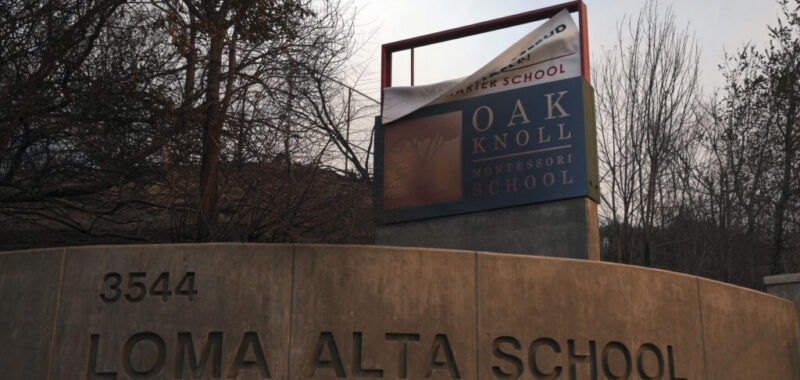
A burned sign at Oak Knoll Montessori School (Loma Alta School) from the Eaton fire on Jan. 9 in the Altadena neighborhood of Pasadena.
Credit: Kirby Lee via AP
As Gov. Gavin Newsom stood near a burned-down school, Pacific Palisades mom Rachel Darvish pleaded with Newsom: “That was my daughter’s school, what are you going to do?” Newsom offered no real answer for the distraught parent at the time.
Well, here’s the answer he should have given: All families affected by the Los Angeles fires should be eligible for emergency education savings accounts that parents can use to pay for education alternatives for their children.
The Los Angeles fires have not only destroyed people’s homes and businesses, they have also razed neighborhood schools. Initial reports indicate at least a dozen schools in the Los Angeles area have burned, affecting more than 5,700 students.
In the Altadena area, which was devastated by the Eaton fire, nearly 2,000 students are school-less.
“I’m just really sad,” one 7-year-old Altadena girl told a CBS-TV reporter, “because I love that school.”
Describing the impact of losing her children’s neighborhood school, an Altadena mom said: “School is a big part of it because it’s the foundation of a family’s daily life. Now we don’t have that anymore.”
The sad reality for affected families is that rebuilding schools, like rebuilding homes, will take a lot of time and money, and only $1 million of Newsom’s $2.5 billion wildfire relief bill was designated for rebuilding schools.
Even in normal times, it takes two years or more to build a school, and school construction costs range from $70 million to $100 million per school.
What are families to do in the meantime?
Many affected families have been dispersed to various parts of Southern California and beyond. Since their homes will not be rebuilt soon, government leaders can address the individual needs of children in this diaspora by giving every child affected by the fires a publicly funded education savings account.
According to the school-choice organization EdChoice, education savings accounts “establish for parents publicly funded government-authorized savings accounts with restricted, but multiple uses for educational purposes,” to be used in-state.
Parents can use these funds to cover “school tuition, tutoring, online education programs, therapies for students with special needs, textbooks or other instructional materials, and sometimes save for college,” whatever policymakers determine. Some programs cover home school costs.
California leaders can model on Arizona, where education savings accounts are funded at 90% of the state’s per-pupil funding, with special needs students receiving higher amounts.
In Newsom’s proposed 2025-26 budget, $83 billion from the state’s general fund would go to K-12 education. Using Arizona as a guide, $12,800 could be made available for these accounts for each affected child.
With thousands of affected students, the total cost for an emergency education savings account program would be around $73 million — a drop in the bucket compared with the billions of dollars in aid being discussed for other aspects of the affected areas.
Education savings accounts are popular with parents. In Arizona, a large majority of parents support such accounts.
For example, after talking with Arizona State Board of Education member Jenny Clark about the state’s education savings account program, one family said, “We continue to utilize the … program to tailor our son’s education to meet both his great strengths and real challenges.”
Today, 18 states from Wyoming to West Virginia have similar programs.
Public schools could be held financially harmless during the existence of these accounts. As EdChoice noted, in states with school choice programs, “many have funding protection policies.” In California’s case, districts could continue to receive their current average daily attendance funding.
Education savings accounts could be funded through the billions of dollars in aid the state will surely receive from the federal government. President Donald Trump would likely look favorably on this program since he proposed a similar program at the federal level in his first administration.
The education savings account program should be reevaluated after a few years to ensure it’s working as designed and improved as needed.
While the catastrophe of the Los Angeles fires has created great uncertainty, one thing is certain: Parents affected by the fires will need the flexibility to pivot and choose educational alternatives that best suit the individual needs of their children.
Parents cannot wait for bureaucratic processes to rebuild the schools that had been. These families need tools right now to pay for and provide for educational services to meet their immediate needs.
“We are so thankful for the educational freedom,” said another Arizona family that used their account funds for a home school hybrid program.
With National School Choice Week upon us, it is a perfect time to give fire-affected Los Angeles parents the freedom and flexibility they so desperately need.
•••
Lance Izumi is senior director of the Center for Education at the Pacific Research Institute, a Pasadena-based think tank advocating for free-market policy solutions, and author of “The Great Classroom Collapse.”
The opinions expressed in this commentary represent those of the author. EdSource welcomes commentaries representing diverse points of view. If you would like to submit a commentary, please review our guidelines and contact us.

